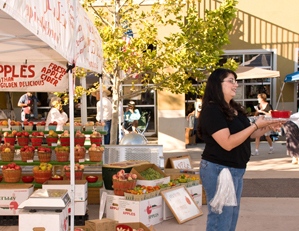Last Updated 2010 - The following suggested guidelines were developed to support the direct marketing of agricultural products through open-air farmers' markets in New Mexico, as well as to protect the health and safety of the consumer.
Adoption of these guidelines alone does not guarantee proper food safety, and the New Mexico Farmers' Marketing Association does not assume any liability arising from the use of these guidelines. These are general guidelines, and markets need to check with their local Environment Department representatives about any local conditions and regulations.
Cooking demonstrations and sampling at farmers' markets can pose legitimate health concerns. The best method for markets to put health officials at ease, and to protect the consumer, is to develop pro-active, comprehensive food handling guidelines. New Mexico farmers' markets do not fit into the existing paradigm of supermarkets, where everything is "sealed for your protection." The suggested guidelines that follow seem to us to be reasonable from the point of view of farmers' markets and vendors, yet do seriously address the health concerns of regulators.
1. Set up a clean preparation area
Vendors should set up a clean preparation area to cut up samples. First clean the area of the table you will be using: use soap and water, and then wipe with a mild bleach solution (1 teaspoon bleach per gallon of water). Or you can use a clean tablecloth.
2. Hand Washing
The easiest way to promote food safety is by washing hands often. At the market, just as at home, we would not think of preparing food for our family without washing our hands first. Ideally, each vendor offering samples should have their own simple hand-washing station at their booth, so that they can wash hands prior to preparing samples as well as when hands become soiled. Markets can also provide a central hand washing station. Hands must be washed after smoking, eating, drinking, using the restroom, or any time contamination occurs. Markets can set up a simple and low-cost hand washing station.
Proper hand washing: wet hands with clean warm water; apply soap and work into a lather; rub hands together for 20 seconds; clean under the nails and between the fingers; rinse under clean, running water; dry hands with a disposable paper towel.
3. Cutting/Preparing samples
Produce used for samples, except for fragile items like berries, must be washed with cool water. Thick-skinned products should be scrubbed with a clean vegetable brush. This removes nearly all insects, dirt, bacteria and some pesticide residues that can contaminate the interior of the produce once it is cut.
Cheeses
Cheese for samples, as well as the prepared samples, should be kept cold (for example by placing on cold packs.)
4. Knives & Utensils
Use clean and sanitized knives, utensils and cutting boards for cutting produce. These items must be brought to market in a clean, sanitized container, and used only for four hours at market. If sampling is done for a period of more than four hours, or whenever items become contaminated (dropped on ground, touched with unwashed hands or raw animal products), then additional sets of sanitized utensils must be used.
To clean and sanitize utensils and cutting boards:
5. Serving Samples
Use single service items to distribute samples to customers. Examples are paper plates, cups, napkins, plastic utensils, wooden sticks or toothpicks. The customer can then dispose of single service items once the product is consumed. Vendors should bring a garbage container for this purpose.
Minimize bare hand contact with cut produce by using tongs. If single service gloves are used, change the gloves often to prevent soiled gloves from cross-contaminating samples. Remember to wash hands between changing gloves.
Vendors should try to avoid contamination of samples by customers. In order to control this, vendors can keep control of the sample plate and offer samples directly to customers. If the plate of samples is to be self-serve, then the plate should be covered, for example with a clear plastic dome.

Interaction between the grower or producer of a food product and the consumer creates a unique forum that fosters the sale of high quality and safe products;
The inspection of food products sold at farmers' markets should follow criteria adapted to a simplified distribution system of foods arriving directly from the farm to the consumer;
Existing regulations can form the basis of practice for developing rules and guidelines suitable for a farm-based business;
It is crucial to ensure the wholesomeness and food safety of un-graded farm-fresh foods to the consumer;
The risk to a consumer of contracting a food-borne illness from farm-fresh products is no greater than that from food products obtained through the current established food distribution system;
The customer may themselves contaminate food after purchase, and need to apply common sense practices such as washing produce prior to use or consumption;
Farmers' markets exist to help small agricultural and food-based businesses and to answer consumers' desire for access to the freshest, high quality food, which is often defined by them as that with the least possible processing or chemical intervention;
All vendors at farmers' markets are subject to inspection by state or local health authorities; and
Generally, only goods produced (grown, harvested, raised, caught, processed) by the vendors may be sold.